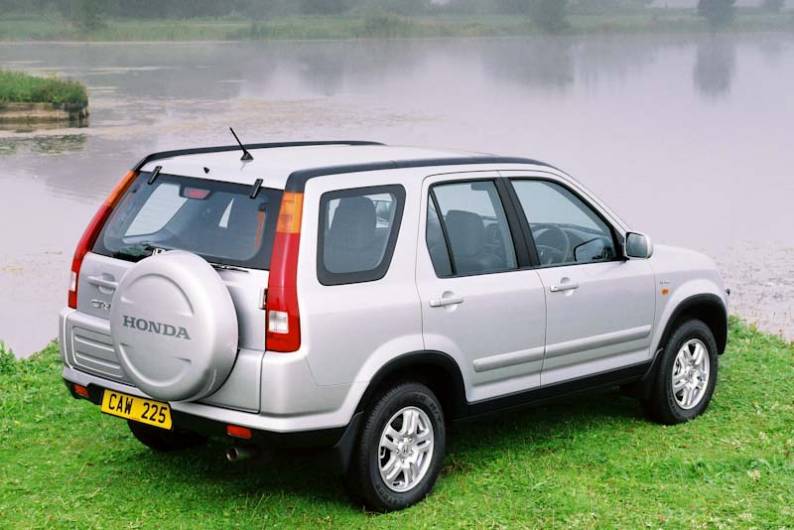
RAC sale – up to 33% off*
• Roadside cover from £5.29 a month†
• We get to most breakdowns in 60 mins or less
• Our patrols fix 4/5 breakdowns on the spot

BY ANDY ENRIGHT
Introduction
The Honda CR-V is one of the best of the breed of compact 4x4s that hit the scene in the early stages of the 21st century. Originally introduced in 1997, the car had a ground-up revision in 2002 in order to keep up with the burgeoning crop of rivals. It's one of the more pragmatic cars of its ilk insofar as it has no real pretensions of being a 'proper' off roader, content instead to offer an elevated seating position and a modicum of muddy track/wet grass all-wheel drive ability.
The smart styling of the post-2002 CR-V reinforced the car's image with younger buyers who had previously considered the car a little conservative. Although rarely mentioned in the same breath as models like the Land Rover Freelander, the Nissan X-Trail or the latest Toyota RAV4, the CR-V is a car that offers used buyers some significant bargains.
Models
Models Covered:
5 dr 4x4, [2.0 VTEC/2.2 CTDi, SE, SE Sport, SE Executive]
History
When the CR-V was first launched back in 1997, the compact 4x4 market was a very different place. The rivals consisted of cars like the Toyota RAV4, Suzuki Vitara, Ford Maverick and Vauxhall Frontera, cars that were pretty easy for the newcomer to pick off at leisure. Since then the opposition has become a lot more accomplished and Honda needed to respond.
The 2001 Tokyo Motor Show was the venue for the world debut of the 'new' CR-V, the only British-built car unveiled at the event. With bolder styling and a number of clever internal features, the CR-V looked set to give rival manufacturers something to think about. The car made its UK debut in Spring 2002. Despite some good reviews, the CR-V hasn't sold in huge numbers, its sales potential initially limited by the absence of a diesel engined version and its thunder stolen by rival offerings.
With such a modest image, used prices are slightly lower than you may expect for such a recent Honda introduction. In late 2003 clear-lens indicators were wheeled-out across the range and the higher spec models received chrome door handles. Further revisions towards the end of 2004 brought new bumpers, a new grille and alterations to the suspension designed to create more car-like dynamics. Then, that long awaited diesel unit arrived in 2005 to give the CR-V renewed impetus in the sales charts. The CR-V was replaced by an all new model late in 2006.
What You Get
We've become used to clever packaging solutions from Honda. The 7th generation Civic hatch displayed enough ingenious MPV-style design features to spawn a whole raft of pretenders. The CR-V is similarly lateral thinking, with one of the most spacious cabins in its class. The two-way tailgate that became one of the old CR-V's trademark features was redesigned to improve functionality. It still kept a separate upper glass hatch, but this is side-hinged like the tailgate, which means that the glass hatch no longer needs to be opened first in order to swing open the tailgate.
The interior is a more mature, considered proposition compared to the first generation CR-V. The tandem distance, the distance between the hip points of front and rear passengers is 1,007mm which was the best in the class at the time, but this space was found without sacrificing luggage capacity thanks to the slightly longer overhangs and a lower floor helped by the compact suspension causing little intrusion into the luggage bay.
Honda's MPV experience shows in the sliding 60/40-split rear bench. These seats tumble forwards into a near-vertical storage position, freeing up enough room to fit two mountain bikes upright without having to remove their front wheels. Even with the seats in place, the load volume ranges from 527 to 628 cubic litres. The much-copied waterproof storage bin positioned under the load floor was retained in this model, but Honda went one step further in turning its lid into a panel that can be used as a bigger, taller, easier to use picnic table.
Three trim levels were offered to UK customers, SE, SE Sport and SE Executive. All variants are equipped with air conditioning, four airbags, CD tuner, electrically adjustable heated door mirrors and a rear accessory power socket. You also get driver's seat height adjustment, the picnic table, remote central locking and electric windows. The SE Sport trim factors in alloy wheels, climate controlled air-con, a sunroof, body coloured bits an outside temperature gauge and a hard spare wheel cover. Find an SE Executive and you'll find that virtually the entire options list is present including leather trim.
What You Pay
Please fill in the form here for an exact up-to-date information.
What to Look For
If the rest of Honda's output is anything to judge by, expect the CR-V to be extremely reliable. Check the service book for main dealer service stamps and the CR-V should be a sound buy. One note of caution, however. Despite its rugged appearance and four-wheel drive underpinnings, the CR-V is not geared up for serious off road work. The front and rear overhangs are sufficiently long to ground out if the going gets rough, and the exhaust box is mounted low, so it may be worthwhile to have a good look at the underside to try to ascertain whether the car in question is sporting any unwanted battle scars.
Replacement Parts
(approx based on an '03 CR-V SE Sport) A holed headlamp unit for your CR-V will set you back around £145. A radiator retails for £142 whilst an alternator is £295 and a replacement starter motor will cost £225. Front brake pads are £45 for a pair whilst an exhaust system costs £380. A replacement catalyst is £440.
On the Road
The only serious Achilles heel of the CR-V was the lack of a high-tech diesel option, although one was added to the range in 2005 and the 2.0-litre 150bhp intelligent VTEC engine is something quite special. It's similar to that found beneath the bonnet of the Stream mini-MPV and, in a significantly gnarlier incarnation, up front in a Civic Type-R. Mated to a manual gearbox it dispatches the sprint to 60mph in around ten seconds and averages over 30mpg.
That said, the engine to have, if you can find it and afford it, is the oil-burner. Honda's i-CTDi common-rail diesel was acclaimed at the time of its launch as perhaps the most refined diesel engines out there. The smooth power delivery is at odds with the peaky turbo diesels employed in rival models and you'll still get from standstill to 60mph in 10.8s and return an average of nearly 45mpg. Not bad at all.
Unlike so many compact 4x4s that offer a roly-poly ride and dismal fuel consumption, the CR-V seems to make sense. Honda's president Nobuhiko Kawamoto once derided the genre when he said, "They are not often used off-road, yet carry around big tyres, diesel engines and heavy military-type transmissions. It's a waste of money." So it is that this CR-V was made even more car-like than its predecessor.
Utilising a development of Honda's compact and technically efficient 'toe control link' McPherson strut front suspension and a sophisticated multi-link set up at the back, the CR-V delivers nimble roll-free handling and accomplished 'grass and gravel' traction. Available with either a floor-mounted five-speed manual or a dash-mounted four-speed automatic, both transmissions are matched to the highly-acclaimed 4WD system that only engages all-wheel drive when it detects wheelspin. Although few would use it to tackle seriously tough terrain, it's nevertheless a practical engineering solution that works for the target market.
One reason why the CR-V has traditionally sold so well is the fact that it can fulfil the roles of two cars in one. The versatility of the cabin and the view from the elevated driving position make urban fetching and carrying less of a chore itself yet the engines are easily game enough to tackle long distance work without a worry.
Overall
If you're not the sort who routinely uses sledgehammers to crack nuts, the Honda CR-V may appeal. With car-like driving characteristics, funky styling and a raised seating position it offers much of the practicality of a 'proper' 4x4 with few of the downsides. Although it sometimes struggles to differentiate itself in an overcrowded used market, the CR-V is a good bet if you value reliability, depth of engineering, a accomplished engines and surprisingly affordable upfront prices.







